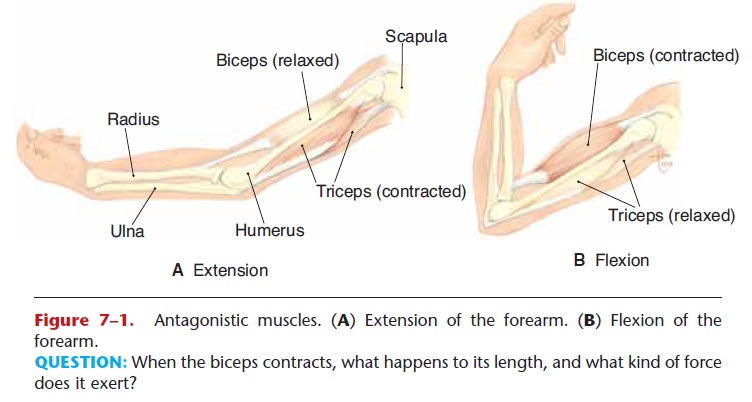Chapter: Essentials of Anatomy and Physiology: The Muscular System
Muscle Tone
MUSCLE TONE
Except during certain stages of sleep, most of our muscles are in a state of slight contraction; this is what is known asmuscle tone. When sitting upright, for example, the tone of your neck muscles keeps your head up, and the tone of your back muscles keeps your back straight. This is an important function of muscle tone for human beings, because it helps us to maintain an upright posture. For a muscle to remain slightly contracted, only a few of the muscle fibers in that muscle must contract. Alternate fibers contract so that the muscle as a whole does not become fatigued. This is similar to a pianist continuously rippling her fingers over the keys of the piano—some notes are always sounding at any given moment, but the notes that are sounding are always changing. This contraction of alternate fibers, muscle tone, is also regulated by the cerebellum of the brain.
Muscle fibers need the energy of ATP (adenosine triphosphate) in order to contract. When they pro-duce ATP in the process of cell respiration, muscle fibers also produce heat. The heat generated by nor-mal muscle tone is approximately 25% of the total body heat at rest. During exercise, of course, heat pro-duction increases significantly.
EXERCISE
Good muscle tone improves coordination. When muscles are slightly contracted, they can react more rapidly if and when greater exertion is necessary. Muscles with poor tone are usually soft and flabby, but exercise will improve muscle tone.
There are two general types of exercise: isotonic and isometric. In isotonic exercise, muscles contract and bring about movement. Jogging, swimming, and weight lifting are examples. Isotonic exercise improves muscle tone, muscle strength, and, if done repetitively against great resistance (as in weight lifting), muscle size. This type of exercise also improves cardiovascu-lar and respiratory efficiency, because movement exerts demands on the heart and respiratory muscles. If done for 30 minutes or longer, such exercise may be called aerobic, because it strengthens the heart and res-piratory muscles as well as the muscles attached to the skeleton.
Isotonic contractions are of two kinds, concentric or eccentric. A concentric contraction is the short-ening of a muscle as it exerts force. An eccentric contraction is the lengthening of a muscle as it still exerts force. Imagine lifting a book straight up (or try it); the triceps brachii contracts and shortens to straighten the elbow and raise the book, a concentric contraction. Now imagine slowly lowering the book. The triceps brachii is still contracting even as it is lengthening, exerting force to oppose gravity (which would make the book drop quickly). This is an eccen-tric contraction.
Isometric exercise involves contraction without movement. If you put your palms together and push one hand against the other, you can feel your arm muscles contracting. If both hands push equally, there will be no movement; this is isometric contraction. Such exercises will increase muscle tone and muscle strength but are not considered aerobic. When the body is moving, the brain receives sensory informa-tion about this movement from the joints involved, and responds with reflexes that increase heart rate and respiration. Without movement, the brain does not get this sensory information, and heart rate and breathing do not increase nearly as much as they would during an equally strenuous isotonic exercise.
Many of our actions involve both isotonic and iso-metric contractions. Pulling open a door requires iso-tonic contractions of arm muscles, but if the door is then held open for someone else, those contractions become isometric. Picking up a pencil is isotonic; holding it in your hand is isometric. Walking uphill involves concentric isotonic contractions, and may be quite strenuous. Walking downhill seems easier, but is no less complex. The eccentric isotonic contractions involved make each step a precisely aimed and controlled fall against gravity. Without such control (which we do not have to think about) a downhill walk would quickly become a roll. These various kinds of contractions are needed for even the simplest activities.

Related Topics